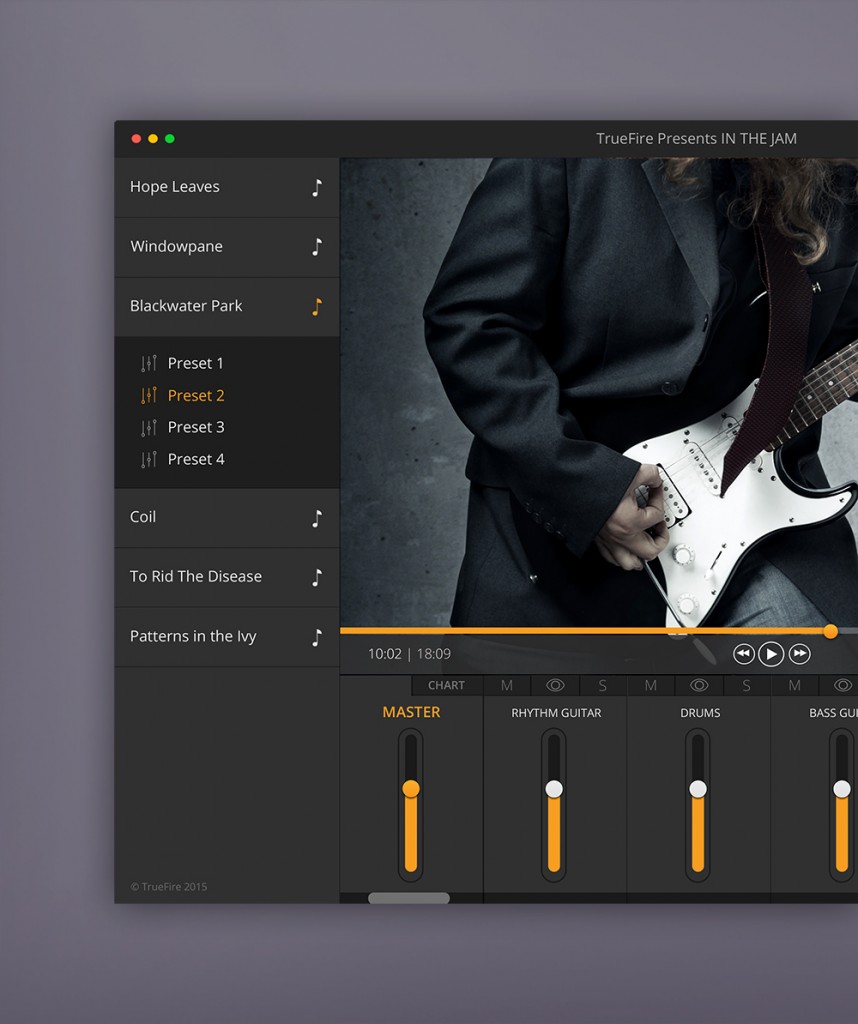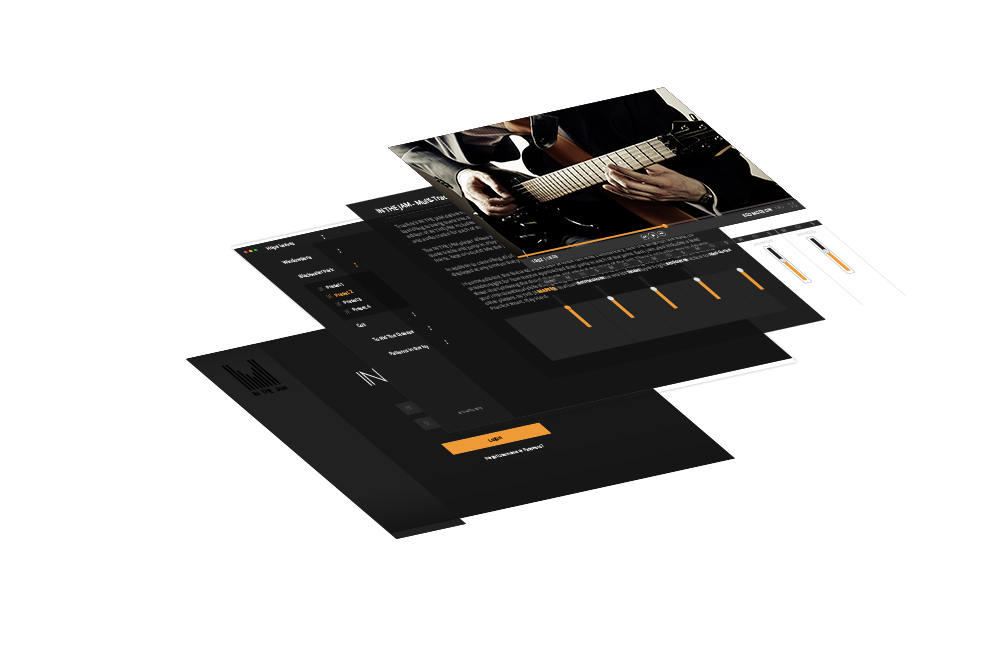In The Jam features world-class artists including Larry Carlton, Robben Ford, Keith Carlock, Steve Smith, Carl Verheyen, Stu Hamm, Frank Vignola, Julian Lage and Tony Monaco among others.
The project took the better part of two years to produce and make available to students due largely to technology development and the many production challenges involved in creating the content.
While everybody at the ‘Fire played a major role in its development, Brad Wendkos and Tommy Jamin led the charge and Godfathered the project, which is why we bring you the following in their own words…
What was the Inspiration behind In The Jam?
BW: My father loved jazz and played several instruments. He would have other musicians over all the time to jam and very often they’d play over a variety vinyl records called Music Minus One. The recordings featured professionally recorded rhythm tracks ‘minus’ the vocalist or one of the instruments. They had a blast with the records and the jams sounded great. That was definitely one of the ‘spark’ concepts for In The Jam.
Primarily though, TrueFire students love to jam over tracks during their practice sessions and so, we started exploring ways that we could make jamming with rhythm tracks more like jamming with real musicians, and pro musicians at that. And to do that we had come up with a way to immerse the student ‘in the jam’ and simulate what really happens on the bandstand.
What “really” happens on the bandstand?
BW: Music is a language and just like any other language, musicians are listening and communicating with each other in real time when they perform together. Learning how to listen is the primary skill that needs to be developed. If you don’t have the opportunity to play out with other musicians, you don’t have the opportunity to develop that skill. That’s the key educational value of working with In The Jam — you learn how to listen.
How?
TJ: We give students the ability to mute, solo or adjust the volume of any of the tracks — in essence, they are mixing their own jam. That process alone requires students to focus on each of the instruments and really hear what’s going on. Once you’re tuned in to what the other musicians are doing, you then have to learn how to interact with your own part.
How does In The Jam help with that?
BW: We struggled with that at first but during the third round of sessions Tommy and I thought we’d have each of the artists record a commentary — like a director’s commentary on a DVD — over each of the tracks where they would talk about what they were hearing from the other band members and how they were responding to it musically. Bingo! Those commentaries reveal so much about the listening, interacting and improvisational process on such a high level way beyond anything we’ve ever done before.
How many have you produced and with whom?
TJ: So far we’ve produced eight editions of In The Jam. We’ve got Robben Ford, Larry Carlton, Robbie Calvo, Frank Vignola with Julian Lage as a duo, Fareed Haque with Tony Monaco on B3 and Steve Smith on Drums, Stu Hamm with Carl Verheyen and Jonathan Mover on drums, and finally there’s Chris Buono with Steve Jenkins on bass and Keith Carlock on drums. We actually just wrapped up a second ITJ edition with Robben where we took all of the content we captured during his album recording sessions for Day In Nashville and we produced additional in-studio performance and commentary content for that. It’s going to be a great one.
Is the In The Jam series just for guitarists?
BW: Absolutely not. This is really the first educational platform we’ve designed with all instruments, even vocalists, in mind. Not only can you mix in or out the guitar parts, you can mute the drums and take on that part, you can mute the bass or keys and join in on those parts. Even horn players can jump in anywhere they like. Every edition of In The Jam is optimized for all instruments.
You guys worked with Keith Carlock and Steve Smith on drums; what was that like?
TJ: Yeah, with Keith there’s just a massive quality to his sound. That guy absolutely crushes the drums! I mean, it all has a killer feel, of course, but his energy on the kit was just intense, and he’s got a great sense of dynamics and power. You can see it in him physically. It’s funny; even when he counted in the grooves he would scream it in! He just drives the groove. Great player.
Steve is a master of feel. With his sound, there’s a rhythmic tightness that you don’t hear every day. He’s definitely a powerful drummer but he’s also so interesting to watch because he seems so centered and calm throughout. I mean the guy wears his shades while he plays! He’d pull off these intricate timings in his fills and patterns, but gracefully and effortlessly. It’s really fun to watch.
We don’t get to do as much drum content as I’d like to, so it was a pleasure working with all of them; Jonathan Mover is another killer drummer that we really enjoyed working with.
What were some of the production challenges?
TJ: The production sort of evolved naturally from project to project. I mean, in the very first edition we shot, which I think was with Robben Ford, we shot him solo and only used audio for all of the other instruments that he had pre-recorded. Each tune only had two video angles, one rhythm performance and one lead performance. In fact, some of the tunes only had a single performance video where he just took a couple of solos power-trio style. Those productions were relatively straightforward and we were able to use our typical course setup to shoot everything.
How did the production evolve from there?
TJ: Years ago when we built this studio, we built it envisioning the potential of bringing a full band in – so we had the space for it. After we had a couple of these in the can, the natural evolution was to get some trios in, so that’s what we did.
The first one we did was guitar, Hammond organ, and drums. Adding two more players meant more cameras, but with drums and keys you’re not just talking about an additional camera; you need several more for each. We needed to capture foot angles for both, overhead views for both, and depending on the shoot we’d incorporate over-the-shoulder and medium shots as well. With multi-camera setups like that you have to stay on top of your operation or you’ll lose something and inevitably ruin the best take from the performers, so it took managing for sure.
One of the greatest aspects of getting to produce these was just being a part of the process; seeing the guys work out the parts on the spot. No doubt, it would have made an already enormous product too big to deliver, but one day I’d love to capture and include the whole process! The guys would come in basically with lead sheets, spend a few minutes working out the changes with each other, and then we’d roll and they’d just improvise like ninety percent of it! Ultimately we ended up shooting something like twelve camera angles including the commentaries. It’s great to get that sort of detail and insight into the way the guys not only play their instruments but also be able to see the way they play off of each other.
Another thing we struggled with in post was whether or not to include tab. I think Brad and I went back and forth a dozen or so times on it – whether this product was about the tabs or not. We ultimately decided that it needed to be in there. It’s one of the things we’ve learned about the way our customers use our products. The tab is always a big bonus; so it’s in there!
All of that sounds like it would be tricky to capture from a technical standpoint?
TJ: It is for sure, and the biggest challenge of having that many cameras in a set is to shoot clean angles without a sloppy mess of grip and camera equipment in the background. I think it really came out well and we were able to accomplish it with mostly gear we have in-house for our course shoots. We set the guys up in an L-shaped configuration with the drums against our cyclorama wall and the other two along the longer wall of the studio. Using a single Image 85 coupled with an eight foot by eight foot diffuser, we lit the subject. We put a similar setup in front of the other two players. We set up some smaller fills for lighting the feet but that was pretty much it. With both sets, we were able to get clean white backgrounds for that TrueFire look with just a pair of 600W incandescent cans and some simple grip for controlling the wash.
For audio we ran everything into Pro Tools. Audio was definitely on a larger scale than our regular course shoots, and on top everything has to be mixed and synced to the video, stems exported and loaded into the player, testing, mix-preset designing, and lots of other things that made these way bigger projects than your average recording session.
One of the things that came along later was a huge overhaul to our technical production setup; as we continued producing more of the trio editions, we’d inject time code into all of the video captures from a master driver in the audio setup, which meant that every camera angle and every audio track locked up automatically in post.
With all of that content in the specialized player software, we also really had to test limitations of different types of computers, download times, playback quality, etc. We had to develop a clever way to effectively play a dozen HD videos and a dozen stereo mp3’s simultaneously without bogging down everyday, run-of-the-mill home computers and laptops. The technical team here worked really hard on that for a long time, and they pulled off a bit of magic I think, really.
How have students responded thus far?
BW: We’ve never had such a massively positive response to one of our new educational platforms as we’ve had with In The Jam. Usually it takes a little time for students to feel out something new but that was definitely not the case here. We really have our creative and technical folks to thank for that as they worked really hard on the interface, making it very intuitive and fun to work with. The project took a very long time to bring to fruition largely due to countless versions of that interface. Looking back now, it was all well worth the wait.
Anything new planned for In The Jam, artist or feature-wise?
BW: Stay tuned…




